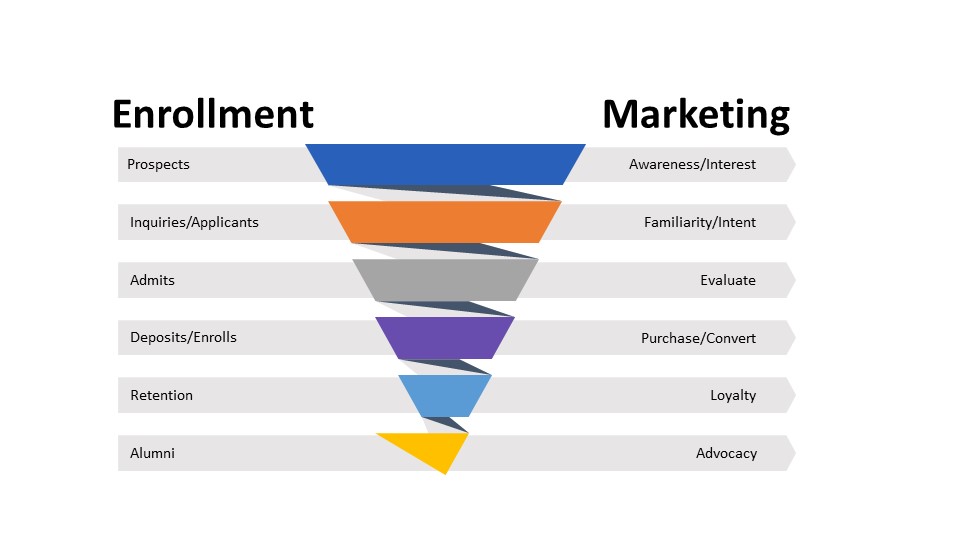
By Ashley Miller, Principle, Principal, Marketing Insights & Analytics, at Purdue University
Oftentimes when you mention the word enrollment to someone, the first thought that comes to mind is recruitment. It’s not lost on anyone how important recruitment strategy and staff are to ensuring enrollment goals are met annually. Being included in the third ASCEND cohort, part of the AACRAO LEAD initiative, we are learning the fundamentals of successful strategic enrollment management (SEM). The true nature of SEM is intended to encompass the full student lifecycle, from activities spanning recruitment through graduation (Sigler, 2017). When you think about the enrollment funnel, the typical stages of prospects, inquiries, applicants, admitted students, deposits, and those who ultimately enroll likely come to mind. As you compare this to a typical marketing funnel, at the top is awareness, followed by familiarity, then a period of evaluation or intent, and ultimately purchase or conversion of a desired action. Marrying the enrollment and marketing funnels is key so we can better understand how one can influence and impact the other in mutually beneficial ways. Marketing is an integral part of enrollment strategy and depending on the size and scope of your institution, there can be many players involved around campus to ensure we are delivering the right message, to the right audience, at the right time in their journey.

The Funnel Doesn’t Stop at Conversion
However, when you think about the bottom of each of these funnels, whether it’s signing up for courses and becoming an enrolled student or taking a desired action such as purchasing a ticket to a university basketball game, the funnel in either case doesn’t end there. Additional stages of the funnel such as loyalty and advocacy show that we want these same audiences to come back for more. For those who work in higher education, our job is to build a relationship with our audiences that lasts beyond the initial interaction. We all have likely heard the adage that “It’s cheaper to retain a current customer than to acquire a new one.” The same is true for us in higher education. We can’t forget about the other stages of the funnel besides getting them to enroll in their first year. If we can foster a good relationship with our students through graduation and beyond, they can become advocates for the institution in a variety of ways either by telling someone else about their experience, coming back for additional education themselves, or becoming a future employee, donor, or fan supporting student sports and success initiatives.
A few questions arise from the role marketing plays in retention: How much marketing engagement happens after a student is enrolled? How can marketing impact the full student lifecycle? Who ultimately is responsible for better assessing, understanding, and influencing the student experience from recruitment to graduation, and beyond? The answers to these questions likely vary depending on the institution and audiences you serve as well as the resources and technology that you have available. There are opportunities to explore the other parts of your enrollment and marketing funnel to optimize the student experience once they are enrolled.
Understanding Students First Year Experience
One way to better optimize the student experience is to map out what a student’s first year will typically look like. How do you measure the first-year student experience at your institution? What are the students’ expectations at the beginning of the school year versus the end? What are students aware or not aware of when it comes to student support, success, and engagement opportunities across campus? Marketing can play a unique and helpful role in these areas through strategic and targeted messaging. Mapping out the student journey throughout their first year can help to align a campus on the touchpoints and messages for these students and what can be influenced to better help with retention efforts. While institutions typically collect information on why students leave, wouldn’t it be better if we collected information on why students come back year after year? Knowing which parts of the experience are going well is just as important as understanding where the gaps might be so we can showcase outcomes and allocate resources appropriately.
Incorporating Analytics into Sense of Belonging
Many institutions utilize analytics from learning management systems to help flag students who may not be meeting academic standards. This is vital information to retention and offers faculty and advisors alike a way to intervene along the student’s academic journey. However, which systems or processes exist to better track student engagement throughout their journey and even more so, their sense of belonging at your institution? Research shows that a higher sense of belonging leads to increased academic motivation, confidence, and achievement (Kelly, 2021). Similarly, for students who have considered leaving their university, a lower sense of belonging is often reported as well, which again can all impact retention efforts. Remember when we referenced the loyalty part of the marketing funnel? Sense of belonging can be a good measure for this and knowing which aspects of their experience contribute to a student’s sense of belonging can provide an opportunity for marketing to engage with this student. In 2020, the National Survey of Student Engagement (NSSE) added three statements to better assess students’ sense of belonging:
I feel comfortable being myself at this institution.
I feel valued by this institution.
I feel like part of the community at this institution.
Gathering this information in an ongoing manner and incorporating it with other data points (such as those from your CRM or other systems) can start to provide a clearer picture on the loyalty measure. Marketing can help with creating consistent messaging and content that ties directly into these statements around belonging.
Collaborative, Coordinated, and Curated Content:
When it comes to who should deliver these messages to students as it relates to their first-year experience, retention efforts, or to further their sense of belonging, a good friend once told me: “Students don’t care about our org charts as much as we do”. Think about it from your own perspective. When you are interacting with a product, service, or brand, etc., at the end of day, do you really care who you talk to or are you more concerned about whether your problem or need will be addressed? My guess is the latter and the same is true for our students. Collaboration though is key as there are many people involved in the full student lifecycle. Coordinating these efforts so we know ‘who’s on first’ is critical to optimize the message and experience to the student. Increasing the number of messages and touchpoints doesn’t necessarily yield better results yet we typically default to a ‘more is better’ approach. A thoughtful, insight-informed, curated plan is more beneficial, so we are meeting students where they are but also balancing the need to be flexible and adaptable. Having a dedicated space to tell stories of your campus maximizes use and reach. At Purdue University, we tell these stories on The Persistent Pursuit. This not only provides engaging content for others to use across campus in their marketing efforts but also gives students an opportunity to see themselves at Purdue University.
It takes a campus to recruit a student and it takes a campus to retain them as well. Marketing can make a significant impact on the entire student lifecycle, which goes well beyond getting students in the door. By optimizing the parts of the marketing funnel around loyalty and advocacy, institutions can reap the benefits by improving retention rates, fostering student success, and building long-lasting relationships that will keep their students coming back for more.